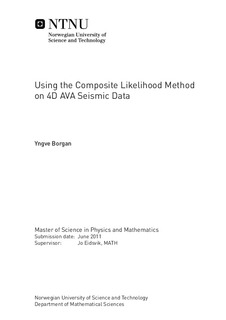Using the Composite Likelihood Method on 4D AVA Seismic Data
Master thesis
Permanent lenke
http://hdl.handle.net/11250/258924Utgivelsesdato
2011Metadata
Vis full innførselSamlinger
Sammendrag
This thesis is concerned with 4D AVA seismic inversion problems. By comparing two seismic surveys done over the same area, but at different times, one hopes to discover untapped pockets of oil or gas. Using the full likelihood to analyse 4D AVA seismic data is impossible in practice due to memory and computational restrictions. The goal of the thesis is to find a useful framework for parameter estimation and predictions for 4D AVA seismic data, and the composite likelihood is introduced as a possible solution. The composite likelihood method takes in pairs of data points and sums over them instead of taking in all the data as is the case for the full likelihood. This makes calculations fast while avoiding matrix operations on large matrices.The composite likelihood method is tested on a data set from the Norne field for parameter estimations and predictions. Eight variations of the model are tested, the variations being the exponential or Matern correlation function, one or two data columns used as a data point in the composite likelihood, and a simple or wavelet convoluted noise term. The composite likelihood method is shown to perform well; it is fast and the estimates found agree well with previous experience. Comparison of the different models indicate that the choice of correlation function has little effect on the results, that the noise term should be kept simple, and that it is sufficient to use one data column.
